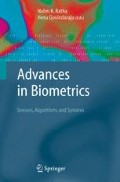Iris recognition is one of the most accurate forms of biometric identifi- cation. However, current commercial off-the-shelf (COTS) systems generally impose significant constraints on the subject. This chapter discusses techniques for iris image capture that reduce those constraints, in particular enabling iris image capture from moving subjects and at greater distances than have been available in the COTS systems. The chapter also includes background information that enables the reader to put these innovations into context.
Access this chapter
Tax calculation will be finalised at checkout
Purchases are for personal use only
Preview
Unable to display preview. Download preview PDF.
References
ACGIH (2004) TLVs ® and BEIs ® ACGIH Cincinnati.
AlMualla. M. (2005) The UAE iris expellees tracking and border control system, Biometrics Consortium Conference Sept., Crystal City, VA. ANSI (2000) ANSI Z136.1 American National Standard for Safe Use of Lasers Laser Institute of America, Orlando.
Bakri, S. (2005) Aniridia in the newborn, www.emedicine.com/OPH/topic317.htm.
Bertillon A. 1886 La couleur de l’iris, Annales de Demographie Internationale 7: 226-246.
Bertillon, A. (1896) Signaletic Instructions Including the Theory and Practice of Anthropometrical Identification. Translated. R.W. McLaughry (Ed.), Werner, Chicago. p. 13.
Biemond, J. Lajendijk, R.F., and Mersereau, R.M. 1990 Interative methods for image deblurring, Proc. IEEE 785: 856-883.
Born, M. and Wolf, E. 1980 Principles of Optics, Pergamon Press, Oxford, p. 419.
Box, G.E.P. (1979) Robustness in the strategy of scientific model building, in Robustness in Statistics. R.L. Launer and G.N. Wilkinson (Eds.), Academic Press, New York.
Boyce, C., Ross, A., Monaco, M., Hornak, L., and Li, X. 2006 Multispectral iris analysis: A preliminary study, Proc. of IEEE Computer Society Workshop on Biometrics, New York, June.
Braithwaite, M., Cahn von Seelen, U., Cambier, J., Daugman, J., Glass, R., Moore, R., and Scott, I. (2004) Application Specific Biometric Templates, US Patent Application 20040193893.
Braithwaite, M., Cahn von Seelen, U., Cambier, J., Daugman, J., Glass, R., Moore, R., and Scott, I. 2002, Application specific biometric templates, Auto ID 2002 Workshop, Tarrytown, NY.
Burt, P.J. and Kolczynski, R.J. (1993) Enhanced image capture through fusion, Proc. Fourth Intl. Conf. On Computer Vision, May, pp. 173-182.
Choi, H.I., Kim, D., Kwon, S., and Lee, S.J. (2004) Modified variable multisector method for iris identification, Biometrics Consortium Conference Sept. 20-22, Crystal City, VA.
Daugman, J. (2006). Private communication.
Daugman, J. (2005) Results from 200 billion iris cross comparisons, University of Cambridge Technical Report UCAM-CL-TR-635.
Daugman, J. 2001 Iris recognition, Am. Scientist 89: 326-333.
Daugman, J. (1994) Biometric Personal Identification System Based on Iris Analysis. U.S. Patent No. 5,291,560 issued 1 March 1994.
Du, Y., Ives, R.W., Etter, D.M., and Welch, T.B.2006 Use of one dimensional iris signatures to rank iris pattern similarities, Optical Eng., 453: 037201-1 to 037201-10.
Flom, L. and Safir, A. 1987 Iris Recognition System, US Patent No 4,661,349.
Gatland, I.R. (2002) Thin lens ray tracing, Am. J. Phys.7012: 1184-1186.
Henderson, R. and Schulmeister K. (2004) Laser Safety, IOP, Bristol.
IBG, International Biometrics Group (2005) Independent testing of iris recognition technology, Final Report, May 2005, NBCHC030114/0002. Study commissioned by the US Department of Homeland Security.
ISO/IEC (2004) Biometric Data Interchange Formats - Part 6: Iris Image Data. ISO/IEC JTC 1/SC 37 N 504.
Janesick, J. (2001) Scientific Charge Coupled Devices SPIE, Bellingham, WA. Kalka, N., Zuo, J., Schmid, N., and Cukic, B. (2006) Fusion of quality esti-mates for an iris biometric vai Dempster-Shafer criterion. preprint, submitted to IEEE Trans. on System, Man, and Cybernetics.
Ma, L., Tan, T., and Wang, Y. 2004 Efficient iris recognition by characterizing key local variations, IEEE Trans. Image Proc. 136: 739-740.
Masek, L. (2003) Recognition of human iris patterns for biometric identification, umpublished thesis, University of Western Australia.
Matey, J.R., Naroditsky, O., Hanna, K., Kolczynski, R., LoIacono, D.J., Mangru, S., Tinker, M., Zappia, T.M., and Zhao, W.Y. 2006 Iris on the MoveTM : Acquisition of images for iris recognition in less constrained environments, Proceedings of the IEEE, 9411: 1936-1947.
Monro, D.M and Zhang, D. 2005 An effective human iris code with low complexity, IEEE International Conference on Image Processing (ICIP), Sept., 3, pp. 277-280.
Narayanswamy, R. (2006) Task based imaging systems optimized for iris recognition, Biometrics Consortium Conference 2006, Baltimore MD.
Narayanswamy, R., Silveira P., Setty, H., Pauca, V., and Gracht, J. (2005) Extended depth of field iris recognition system for a workstation environ-ment, Proceedings SPIE Conf. On Biometrics for Human Identification, March, pp. 41-50.
Phillips, P.J. (2006) ICE 2005 results, presented at FRGC and ICE Workshop March 22, 2006 Arlington VA. Available at iris.nist.gov/ICE.
Sliney, D. and Wolbarsht, M. 1980 Safety with Lasers and Other Optical Sources. Plenum, New York.
Wildes, R.P., Asmuth, J.C., Hsu, S.C., Kolczynski, R.J., Matey, J.R., and McBride, S.E. 1996 Automated, noninvasive iris recognition system and method, U.S. Patent 5 572 596.
Author information
Authors and Affiliations
Editor information
Editors and Affiliations
Rights and permissions
Copyright information
© 2008 Springer-Verlag London Limited
About this chapter
Cite this chapter
Matey, J.R., Ackerman, D., Bergen, J., Tinker, M. (2008). Iris Recognition in Less Constrained Environments. In: Ratha, N.K., Govindaraju, V. (eds) Advances in Biometrics. Springer, London. https://doi.org/10.1007/978-1-84628-921-7_7
Download citation
DOI: https://doi.org/10.1007/978-1-84628-921-7_7
Publisher Name: Springer, London
Print ISBN: 978-1-84628-920-0
Online ISBN: 978-1-84628-921-7
eBook Packages: Computer ScienceComputer Science (R0)

